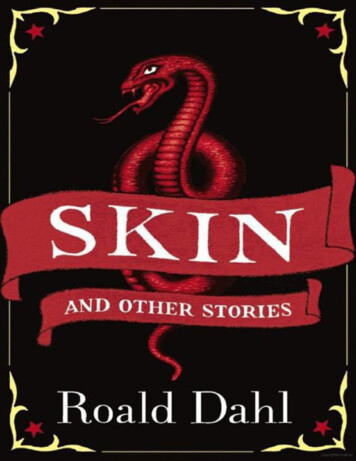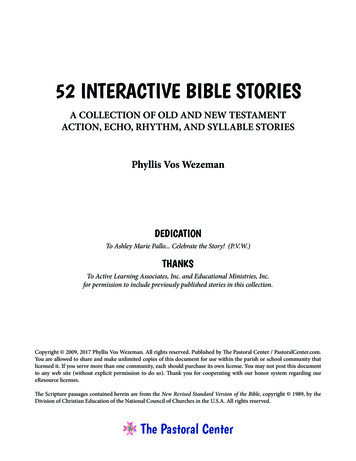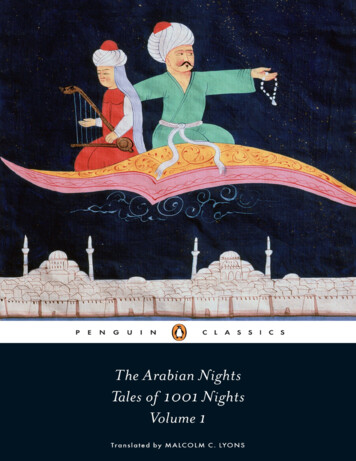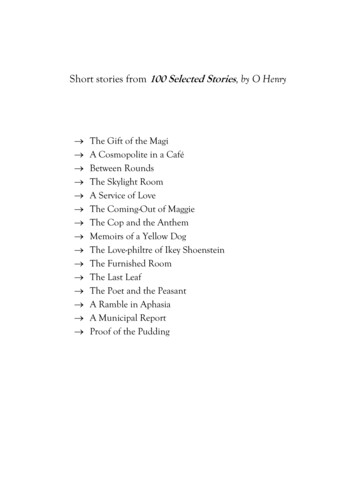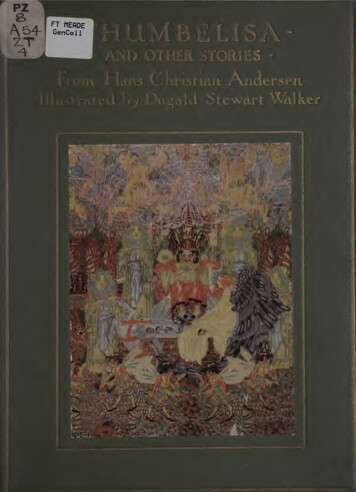
Transcription
GenCol1Stewart
THUMBELISAAND OTHER STORIES
II
\ou shall not be called Ihumbelisa, that is such an ugly name, andyou are so pretty. We will call you May”
PZg. A54-ZTfILLUSTRATIONS AND DECORATIONSCOPYRIGHT, 1914, BYDOUBLEDAY, PAGE & COMPANYALL RIGHTS RESERVED, INCLUDING THAT OF TRANSLATIONINTO FOREIGN LANGUAGES, INCLUDING THE SCANDINAVIANTrawfen'gd frumReadingPRINTED IN THE UNITED STATESATTHE COUNTRY LIFE PRESS, GARDEN CITY, N. Y
List of IllustrationsColoured“ You shall not be called Thumbelisa, that is such an ugly name, and you are sopretty. We will call you May.”“The Day-spring from on high hath visited us. To give light to them that sitin darkness, and to guide their feet into the way of peace.”The courtiers looked most grand and properelves danced around the hall.Numbers of tiny littleBlack and WhiteShe was so happy now, because the toad could not reach her and she was sailingthrough such lovely scenes.She who is related to the fairies!“You shouldn’t even tell me anything of the sort just now, it might have a badeffect upon the eggs.”The great dragon, hoarding his treasures, raised his head to look at them.Great spiders spun their webs from branch to branch . . . and the fairiesswung hand in hand upon the big dewdrops which covered the leaves andthe long grass.Oh, what a flight that was through the air; the wind caught her cloak, and themoon shone through it.
THUMBELISAAND OTHER STORIES
THERE was once a woman who had the greatest longingfor a little tiny child, but she had no idea where to getone; so she went to an old witch and said to her, “I doso long to have a little child, will you tell me where I can getone?”“Oh, we shall be able to manage that,” said the witch.“Here is a barley corn for you; it is not at all the same kindas that which grows in the peasant’s field, or with which chickensare fed; plant it in a flower pot and you will see what will appear.”“Thank you, oh, thank you!” said the woman, and shegave the witch twelve pennies, then went home and plantedthe barley corn, and a large, handsome flower sprang up atonce; it looked exactly like a tulip, but the petals were tightlyshut up, just as if they were still in bud. “That is a lovelyflower,” said the woman, and she kissed the pretty red andyellow petals; as she kissed it the flower burst open with aloud snap. It was a real tulip, you could see that; but rightin the middle of the flower on the green stool sat a little tiny
ANDERSEN’SFAIRYTALESgirl, most lovely and delicate; she was not more than an inchin height, so she was called Thumbelisa.Her cradle was a smartly varnished walnut shell, with theblue petals of violets for a mattress and a rose-leaf to coverher; she slept in it at night, but during the day she playedabout on the table where the woman had placed a plate, sur rounded by a wreath of flowers on the outer edge with theirstalks in water. A large tulip petal floated on the waterand on this little Thumbelisa sat and sailed about from oneside of the plate to the other; she had two white horsehairsfor oars. It was a pretty sight. She could sing, too, withsuch delicacy and charm as was never heard before.One night as she lay in her pretty bed, a great ugly toadhopped in at the window, for there was a broken pane. Ugh!how hideous that great wet toad was; it hopped right downon to the table where Thumbelisa lay fast asleep, under thered rose-leaf.“Here is a lovely wife for my son,” said the toad, and thenshe took up the walnut shell where Thumbelisa slept andhopped away with it through the window, down into the garden.A great broad stream ran through it, but just at the edge itwas swampy and muddy, and it was here that the toad livedwith her son. Ugh! how ugly and hideous he was too, exactlylike his mother. “Koax, koax, brekke-ke-kex,” that was allhe had to say when he saw the lovely little girl in the walnutshell.“Do not talk so loud or you will wake her,” said the oldtoad; “she might escape us yet, for she is as light as thistle down! We will put her on one of the broad water-lily leavesout in the stream; it will be just like an island to her, she is sosmall and light. She won’t be able to run away from therewhile we get the stateroom ready down under the mud, whichyou are to inhabit.”A great many water lilies grew in the stream, their broadgreen leaves looked as if they were floating on the surface of
THUMBELIS Athe water. The leaf which was farthest from the shore wasalso the biggest and to this one the old toad swam out withthe walnut shell in which little Thumbelisa lay.The poor, tiny little creature woke up quite early in themorning, and when she saw where she was she began to crymost bitterly, for there was water on every side of the biggreen leaf, and she could not reach the land at any point.The old toad sat in the mud decking out her abode withgrasses and the buds of the yellow water lilies, so as to haveit very nice for the new daughter-in-law, and then she swamout with her ugly son to the leaf where Thumbelisa stood;they wanted to fetch her pretty bed to place it in the bridalchamber before they took her there. The old toad made adeep curtsey in the water before her, and said, “Here is myson, who is to be your husband, and you are to live togethermost comfortably down in the mud.”“Koax, koax, brekke-ke-kex,” that was all the son couldsay.Then they took the pretty little bed and swam away withit, but Thumbelisa sat quite alone on the green leaf and criedbecause she did not want to live with the ugly toad, or haveher horrid son for a husband. The little fish which swamabout in the water had no doubt seen the toad and heardwhat she said, so they stuck their heads up, wishing, I suppose,to see the little girl. As soon as they saw her, they were delightedwith her, and were quite grieved to think that she was to godown to live with the ugly toad. No, that should never happen.They flocked together down in the water round about the greenstem which held the leaf she stood upon, and gnawed at it withtheir teeth till it floated away down the stream carrying Thum belisa away where the toad could not follow her.Thumbelisa sailed past place after place, and the littlebirds in the bushes saw her and sang, “what a lovely littlemaid.” The leaf with her on it floated farther and fartheraway and in this manner reached foreign lands.
ANDERSEN’SFAIRYTALESA pretty little white butterfly fluttered round and roundher for some time and at last settled on the leaf, for it hadtaken quite a fancy to Thumbelisa: she was so happy now,because the toad could not reach her and she was sailing throughsuch lovely scenes; the sun shone on the water and it lookedlike liquid gold. Then she took her sash and tied one endround the butterfly, and the other she made fast to the leafwhich went gliding on quicker and quicker, and she with it,for she was standing on the leaf.At this moment a big cockchafer came flying along; hecaught sight of her and in an instant he fixed his claw roundher slender waist and flew off with her up into a tree, but thegreen leaf floated down the stream and the butterfly with it,for he was tied to it and could not get loose.Heavens! how frightened poor little Thumbelisa was whenthe cockchafer carried her up into the tree, but she was mostof all grieved about the pretty white butterfly which she hadfastened to the leaf; if he could not succeed in getting loosehe would be starved to death.But the cockchafer cared nothing for that. He settledwith her on the largest leaf on the tree, and fed her with honeyfrom the flowers, and he said that she was lovely althoughshe was not a bit like a chafer. Presently all the other chaferswhich lived in the tree came to visit them; they looked atThumbelisa and the young lady chafers twitched their feelersand said, “She has also got two legs, what a good effect it has.”“She has no feelers,” said another. “She is so slender in thewaist, fie, she looks like a human being.” “How ugly she is,”said all the mother chafers, and yet little Thumbelisa was sopretty. That was certainly also the opinion of the cockchaferwho had captured her, but when all the others said she was ugly,he at last began to believe it, too, and would not have anythingmore to do with her, she might go wherever she liked! Theyflew down from the tree with her and placed her on a daisy,where she cried because she was so ugly that the chafers would
She was so happy now, because the toad could not reach herand she was sailing through such lovely scenes
THUMBELIS Ahave nothing to do with her; and, after all, she was more beau tiful than anything you could imagine, as delicate and trans parent as the finest rose-leaf.Poor little Thumbelisa lived all the summer quite alonein the wood. She plaited a bed of grass for herself and hungit up under a big dock-leaf which sheltered her from the rain;she sucked the honey from the flowers for her food, and her drinkwas the dew which lay on the leaves in the morning. In thisway the summer and autumn passed, but then came the winter.All the birds which used to sing so sweetly to her flew away,the great dock-leaf under which she had lived shrivelled up,leaving nothing but a dead yellow stalk, and she shivered withthe cold, for her clothes were worn out; she was such a tinycreature, poor little Thumbelisa, she certainly must be frozento death. It began to snow and every snowflake which fellupon her was like a whole shovelful upon one of us, for we arebig and she was only one inch in height. Then she wrappedherself up in a withered leaf, but that did not warm her much,she trembled with the cold.Close to the wood in which she had been living lay a largecornfield, but the corn had long ago been carried away andnothing remained but the bare, dry stubble which stood upout of the frozen ground. The stubble was quite a forest forher to walk about in: oh, how she shook with the cold. Thenshe came to the door of a field-mouse’s home. It was a littlehole down under the stubble. The field-mouse lived so cosilyand warm there, her whole room was full of corn, and shehad a beautiful kitchen and larder besides. Poor Thumbelisastood just inside the door like any other poor beggar childand begged for a little piece of barley corn, for she had hadnothing to eat for two whole days.“You poor little thing,” said the field-mouse, for she wasat bottom a good old field-mouse. “Come into my warmroom and dine with me.” Then, as she took a fancy to Thum belisa, she said, “You may with pleasure stay with me for the
ANDERSEN’SFAIRYTALES winter, but you must keep my room clean and tidy and tellme stories, for I am very fond of them,” and Thumbelisadid what the good old field-mouse desired and was on thewhole very comfortable.“Now we shall soon have a visitor,” said the field-mouse;“my neighbour generally comes to see me every week-day.He is even better housed than I am; his rooms are very large,and he wears a most beautiful black velvet coat; if only youcould get him for husband you would indeed be well settled,but he can’t see. You must tell him all the most beautifulstories you know.”But Thumbelisa did not like this, and she would havenothing to say to the neighbour, for he was a mole. He cameand paid a visit in his black velvet coat. He was very rich andwise, said the field-mouse, and his home was twenty timesas large as hers; and he had much learning, but he did not likethe sun or the beautiful flowers, in fact he spoke slightinglyof them, for he had never seen them. Thumbelisa had to singto him, and she sang both “Fly away, cockchafer” and “Amonk, he wandered through the meadow,” then the mole fellin love with her because of her sweet voice, but he did notsay anything, for he was of a discreet turn of mind.He had just made a long tunnel through the ground fromhis house to theirs, and he gave the field-mouse and Thumbelisaleave to walk in it whenever they liked. He told them notto be afraid of the dead bird which was lying in the passage.It was a whole bird with feathers and beak which had probablydied quite recently at the beginning of the winter and wasnow entombed just where he had made his tunnel.The mole took a piece of tinder-wood in his mouth, forthat shines like fire in the dark, and walked in front of themto light them in the long dark passage; when they came tothe place where the dead bird lay, the mole thrust his broadnose up to the roof and pushed the earth up so as to makea big hole through which the daylight shone. In the middle
THUMBELISAof the floor lay a dead swallow, with its pretty wings closelypressed to its sides, and the legs and head drawn in underthe feathers; no doubt the poor bird had died of cold. Thumbelisa was so sorry for it; she loved all the little birds, for theyhad twittered and sung so sweetly to her during the wholesummer; but the mole kicked it with his short legs and said,“Now it will pipe no more! It must be a miserable fate tobe born a little bird! Thank heaven! no child of mine canbe a bird; a bird like that has nothing but its twitter and diesof hunger in the winter.”“Yes, as a sensible man, you may well say that,” saidthe field-mouse. “What has a bird for all its twittering whenthe cold weather comes? It has to hunger and freeze, butthen it must cut a dash.”Thumbelisa did not say anything, but when the othersturned their backs to the bird, she stooped down and strokedaside the feathers which lay over its head, and kissed its closedeyes. “Perhaps it was this very bird which sang so sweetlyto me in the summer,” she thought; “what pleasure it gaveme, the dear pretty bird.”The mole now closed up the hole which let in the daylightand conducted the ladies to their home. Thumbelisa couldnot sleep at all in the night, so she got up out of her bed andplaited a large handsome mat of hay and then she carriedit down and spread it all over the dead bird, and laid some softcotton wool which she had found in the field-mouse’s roomclose round its sides, so that it might have a warm bed onthe cold ground.“Good-bye, you sweet little bird,” said she, “good-bye,and thank you for your sweet song through the summer whenall the trees were green and the sun shone warmly upon us.”Then she laid her head close up to the bird’s breast, but wasquite startled at a sound, as if something was thumping insideit. It was the bird’s heart. It was not dead but lay in aswoon, and now that it had been warmed it began to revive.
ANDERSEN’SFAIRYTALESIn the autumn all the swallows fly away to warm countries,Aut if one happens to be belated, it feels the cold so muchthat it falls down like a dead thing, and remains lying whereit falls till the snow covers it up. Thumbelisa quite shookwith fright, for the bird was very, very big beside her, who wasonly one inch high; but she gathered up her courage, packedthe wool closer round the poor bird, and fetched a leaf of mintwhich she had herself for a coverlet, and laid it over the bird’shead. The next night she stole down again to it and foundit alive but so feeble that it could only just open its eyes fora moment to look at Thumbelisa who stood with a bit of tinderwood in her hand, for she had no other lantern.“Many, many thanks, you sweet child,” said the sickswallow to her; “you have warmed me beautifully. I shallsoon have strength to fly out into the warm sun again.”“Oh!” said she, “it is so cold outside, it snows and freezes,stay in your warm bed, I will tend you.” Then she broughtwater to the swallow in a leaf, and when it had drunk someit told her how it had torn its wing on a blackthorn bush,and therefore could not fly as fast as the other swallows whichwere taking flight then for the distant warm lands. At lastit fell down on the ground, but after that it remembered nothingand did not in the least know how it had got into the tunnel.It stayed there all the winter, and Thumbelisa was goodto it and grew very fond of it. She did not tell either the moleor the field-mouse anything about it, for they did not like thepoor unfortunate swallow.As soon as the spring came and the warmth of the sunpenetrated the ground, the swallow said good-bye to Thumbelisa,who opened the hole which the mole had made above. Thesun streamed in deliciously upon them, and the swallowasked if she would not go with him; she could sit upon his backand they would fly far away into the green wood. But Thum belisa knew that it would grieve the old field-mouse if she lefther like that.
THUMBELIS A“No, I can’t,” said Thumbelisa.“Good-bye, good-bye, then, you kind pretty girl,” saidthe swallow, and flew out into the sunshine. Thumbelisalooked after him and her eyes filled with tears, for she was veryfond of the poor swallow.“Tweet, tweet,” sang the bird, and flew into the greenwood.Thumbelisa was very sad. She was not allowed to goout into the warm sunshine at all; the corn which was sownin the field near the field-mouse’s house grew quite long; itwas a thick forest for the poor little girl who was only an inchhigh.“You must work at your trousseau this summer,” said thefield-mouse to her, for their neighbour the tiresome mole in hisblack velvet coat had asked her to marry him. “You shallhave both woollen and linen, you shall have wherewith toclothe and cover yourself when you become the mole’s wife.”Thumbelisa had to turn the distaff and the field-mouse hiredfour spiders to spin and weave day and night. The molepaid a visit every evening, and he was always saying that whenthe summer came to an end the sun would not shine nearlyso warmly, now it burnt the ground as hard as a stone. Yes,when the summer was over he would celebrate his marriage;but Thumbelisa was not at all pleased, for she did not care abit for the tiresome mole. Every morning at sunrise and everyevening at sunset she used to steal out to the door, and whenthe wind blew aside the tops of the cornstalks so that she couldsee the blue sky, she thought how bright and lovely it wasout there, and wished so much to see the dear swallow again;but it never came back; no doubt it was a long way off, flyingabout in the beautiful green woods.When the autumn came all Thumbelisa’s outfit was ready.“In four weeks you must be married,” said the fieldmouse to her. But Thumbelisa cried and said that she wouldnot have the tiresome mole for a husband.
ANDERSEN’SFAIRYTALES“Fiddle-dee-dee,” said the field-mouse: “don’t be obstinateor I shall bite you with my white tooth. You are going tohave a splendid husband; the queen herself hasn’t the equalof his black velvet coat; both his kitchen and his cellar arefull. You should thank heaven for such a husband!”So they were to be married; the mole had come to fetchThumbelisa; she was to live deep down under the groundwith him, and never to go out into the warm sunshine, forhe could not bear it. The poor child was very sad at thethought of bidding good-bye to the beautiful sun; while shehad been with the field-mouse she had at least been allowedto look at it from the door.“Good-bye, you bright sun,” she said as she stretched outher arms toward it and went a little way outside the fieldmouse’s house, for now the harvest was over and only thestubble remained. “Good-bye, good-bye!” she said, andthrew her tiny arms round a little red flower growing there.“Give my love to the dear swallow if you happen to see him.”“Tweet, tweet,” she heard at this moment above herhead.She looked up; it was the swallow just passing.Assoon as it saw Thumbelisa it was delighted; she told it howunwilling she was to have the ugly mole for a husband, andthat she was to live deep down underground where the sunnever shone. She could not help crying about it.“The cold winter is coming,” said the swallow, “and Iam going to fly away to warm countries. Will you go withme? You can sit upon my back! Tie yourself on withyour sash; then we will fly away from the ugly mole andhis dark cavern, far away over the mountains to those warmcountries where the sun shines with greater splendour thanhere, where it is always summer and there are heaps of flow ers. Do fly with me, you sweet little Thumbelisa, who savedmy life when I lay frozen in the dark earthy passage.”“Yes, I will go with you,” said Thumbelisa, seating her self on the bird’s back, with her feet on its outspread wings.
THUMBELISAShe tied her band tightly to one of the strongest feathers, andthen the swallow flew away, high up in the air above forestsand lakes, high up above the biggest mountains where the snownever melts; and Thumbelisa shivered in the cold air, butthen she crept under the bird’s warm feathers, and only stuckout her little head to look at the beautiful sights beneath her.Then at last they reached the warm countries. The sunshone with a warmer glow than here; the sky was twice ashigh, and the most beautiful green and blue grapes grew inclusters on the banks and hedgerows. Oranges and lemonshung in the woods, which were fragrant with myrtles andsweet herbs, and beautiful children ran about the roads play ing with the large gorgeously coloured butterflies. But theswallow flew on and on, and the country grew more and morebeautiful. Under magnificent green trees on the shores ofthe blue sea stood a dazzling white marble palace of ancientdate; vines wreathed themselves round the stately pillars.At the head of these there were countless nests, and the swal low who carried Thumbelisa lived in one of them.“Here is my house,” said the swallow; “but if you willchoose one of the gorgeous flowers growing down there, I willplace you in it, and you will live as happily as you can wish.”“That would be delightful,” she said, and clapped herlittle hands.A great white marble column had fallen to the groundand lay there broken in three pieces, but between these themost lovely white flowers grew. The swallow flew downwith Thumbelisa and put her upon one of the broad leaves;what was her astonishment to find a little man in the middleof the flower, as bright and transparent as if he had been madeof glass. He had a lovely golden crown upon his head andthe most beautiful bright wings upon his shoulders; he wasno bigger than Thumbelisa. He was the angel of the flowers.There was a similar little man or woman in every flower, buthe was the king of them all.
ANDERSEN’S FAIRYTALES“Heavens, how beautiful he is,” whispered Thumbelisato the swallow. The little prince was quite frightened bythe swallow, for it was a perfect giant of a bird to him, hewho was so small and delicate, but when he saw Thumbelisahe was delighted; she was the very prettiest girl he had everseen. He therefore took the golden crown off his own headand placed it on hers, and asked her name, and if she wouldbe his wife, and then she would be queen of the flowers! Yes,he was certainly a very different kind of husband from thetoad’s son, or the mole with his black velvet coat. So sheaccepted the beautiful prince, and out of every flower steppeda little lady or a gentleman so lovely that it was a pleasure tolook at them. Each one brought a gift to Thumbelisa, butthe best of all was a pair of pretty wings from a large white fly;they were fastened on to her back, and then she too could flyfrom flower to flower. All was then delight and happiness,but the swallow sat alone in his nest and sang to them as wellas he could, for his heart was heavy, he was so fond of Thum belisa himself, and would have wished never to part from her.“You shall not be called Thumbelisa,” said the angel ofthe flower to her; “that is such an ugly name, and you areso pretty. We will call you May.”“Good-bye, good-bye,” said the swallow, and flew awayagain from the warm countries, far away back to Denmark;there he had a little nest above the window where the manlived who wrote this story, and he sang his “tweet, tweet,”to the man, and so we have the whole story.
THE storks have a great many stories, which they telltheir little ones, all about the bogs and the marshes.They suit them to their ages and capacity. The youngestones are quite satisfied with “Kribble krabble,” or some suchnonsense; but the older ones want something with more mean ing in it, or at any rate something about the family. Weall know one of the two oldest and longest tales which have beenkept up among the storks; the one about Moses, who wasplaced by his mother on the waters of the Nile, and foundthere by the king’s daughter. How she brought him up andhow he became a great man whose burial place nobody to thisday knows. This is all common knowledge.The other story is not known yet, because the storkshave kept it among themselves. It has been handed on fromone mother stork to another for more than a thousand years,and each succeeding mother has told it better and better, tillwe now tell it best of all.The first pair of storks who told it, and who actually
ANDERSEN’SFAIRYTALESlived it, had their summer quarters on the roof of the Viking’stimbered house up by “Vidmosen” (the Wild Bog) in Wendsyssel. It is in the county of Hiorring, high up toward theSkaw, in the north of Jutland, if we are to describe it accordingto the authorities. There is still a great bog there, which wemay read about in the county chronicles. This district usedto be under the sea at onetime, but the ground has risen, andit stretches for miles. It is surrounded on every side by marshymeadows, quagmires, and peat bogs, on which grow cloud berriesand stunted bushes. There is nearly always a damp misthanging over it, and seventy years ago it was still overrunwith wolves. It may well be called the Wild Bog, and onecan easily imagine how desolate and dreary it was amongall these swamps and pools a thousand years ago. In detaileverything is much the same now as it was then. The reedsgrow to the same height, and have the same kind of long pur ple-brown leaves with feathery tips as now. The birch stillgrows there with its white bark and its delicate loosely hang ing leaves. With regard to living creatures, the flies still weartheir gauzy draperies of the same cut; and the storks now,as then, still dress in black and white, with long red stockings.The people certainly then had a very different cut for theirclothes than at the present day; but if any of them, serf orhuntsman, or anybody at all, stepped on the quagmires, thesame fate befell him a thousand years ago as would overtakehim now if he ventured on them — in he would go, and downhe would sink to the Marsh King, as they call him. Herules down below over the whole kingdom of bogs and swamps.He might also be called King of the Quagmires, but we preferto call him the Marsh King, as the storks did. We knowvery little about his rule, but that is perhaps just as well.Near the bogs, close to the arm of the Cattegat, calledthe Limfiord, lay the timbered hall of the Vikings with itsstone cellar, its tower, and its three storeys. The storks hadbuilt their nest on the top of the roof, and the mother stork was
She who is related to the fairies!
THEMARSHKING’SDAUGHTERsitting on the eggs which she was quite sure would soon besuccessfully hatched.One evening Father Stork stayed out rather late, andwhen he came back he looked somewhat ruffled.“I have something terrible to tell you!” he said to themother stork.“Don’t tell it tome then,” she answered; “remember thatI am sitting; it might upset me and that would be bad forthe eggs!”“You will have to know it,” said he; “she has come here,the daughter of our host in Egypt. She has ventured to takethe journey, and now she has disappeared.”“She who is related to the fairies! Tell me all about it.You know I can’t bear to be kept waiting now I am sitting.”“Look here, mother! She must have believed what thedoctor said as you told me; she believed that the marsh flowersup here would do something for her father, and she flew overhere in feather plumage with the other two Princesses, whohave to come north every year to take the baths to make them selves young. She came, and she has vanished.”“You go into too many particulars,” said the motherstork; “the eggs might get a chill, and I can’t stand beingkept in suspense.”“I have been on the outlook,” said Father Stork, “andto-night when I was among the reeds where the quagmirewill hardly bear me, I saw three swans flying along, andthere was something about their flight which said to me,‘Watch them, they are not real swans! They are only in swans’plumage.’ You know, mother, as well as I, that one feelsthings intuitively, whether or not they are what they seemto be.”“Yes, indeed!” she said, “but tell me about the Princess.I am quite tired of hearing about swan’s plumage.”“You know that in the middle of the bog there is a kindof lake,” said Father Stork. “You can see a bit of it if you
ANDERSEN’SFAIRYTALESraise your head. Well, there was a big alder stump betweenthe bushes and the quagmire, and on this the three swanssettled, flapping their wings and looking about them. Thenone of them threw off the swan’s plumage, and I at oncerecognized in her our Princess from Egypt. There she satwith no covering but her long black hair; I heard her begthe two others to take good care of the swTan’s plumage whileshe dived under the water to pick up the marsh flower whichshe thought she could see. They nodded and raised theirheads, and lifted up the loose plumage. What are they goingto do with it, thought I, and she no doubt asked them thesame thing; and the answer came, she had ocular demonstra tion of it: they flew up into the air with the feather garment!‘Just you duck down,’ they cried. ‘Never again will youfly about in the guise of a swan; never more will you see theland of Egypt; you may sit in your swamp.’ Then they torethe feather garment into a hundred bits, scattering the feathersall over the place, like a snowstorm; then away flew thosetwo good-for-nothing Princesses.”“What a terrible thing!” said Mother Stork; “but I musthave the end of it.”“The Princess moaned and wept! Her tears trickleddown upon the alder stump, and then it began to move, f
ANDERSEN’S FAIRY TALES . A pretty little white butterfly fluttered round and round her for some time and at last settled on the leaf, for it had . me stories, for I am very fond of them,” and Thumbelisa . But Thumbelisa did not





